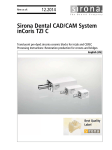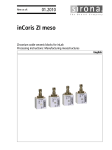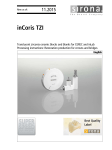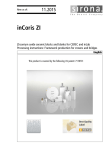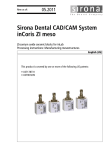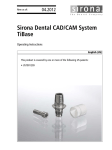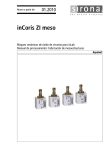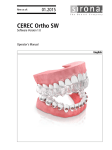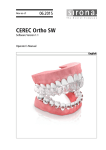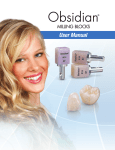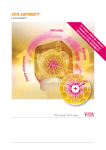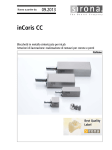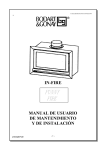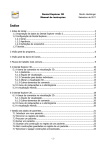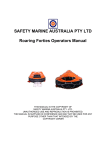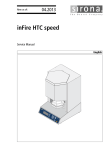Download inCoris TZI Instructions
Transcript
kÉï=~ë=çÑW== NNKOMNN áå`çêáë=qwf qê~åëäìÅÉåí=òáêÅçåá~=ÅÉê~ãáÅ=ÄäçÅâë=Ñçê=áåi~Ä mêçÅÉëëáåÖ=áåëíêìÅíáçåëW=oÉëíçê~íáçå=éêçÇìÅíáçå=Ñçê=Åêçïåë=~åÇ=ÄêáÇÖÉë båÖäáëÜ Translucent zirconia ceramic blocks for inLab\r processing instructions: Restoration production for crowns and bridges Sirona Dental Systems GmbH Translucent zirconia ceramic blocks for inLab Table of contents 1 General..................................................................................................................... 3 2 Material..................................................................................................................... 4 3 Chemical composition .............................................................................................. 5 4 Technical data .......................................................................................................... 6 5 Indication and preparation instructions..................................................................... 7 5.1 Indication ....................................................................................................... 7 5.2 Contraindications .......................................................................................... 7 5.3 General preparation instructions ................................................................... 7 5.4 Preparation of premolars and molars ............................................................ 7 5.5 Preparation of anterior and posterior tooth crowns ....................................... 8 Creating the restoration............................................................................................ 9 6.1 Scanning, designing and milling.................................................................... 9 6.2 Reworking the milled restoration ................................................................... 9 6.3 Pre-drying...................................................................................................... 9 6.4 Coloring ......................................................................................................... 9 6.4.1 Brush technique (multicoloring).......................................................... 10 6.4.2 Dipping ............................................................................................... 12 6.5 Sintering ........................................................................................................ 13 6.6 Additional notes: procedure after sintering.................................................... 14 6.7 Rework .......................................................................................................... 14 6.8 Painting and coating...................................................................................... 14 7 Recommended tools and materials.......................................................................... 15 8 Fastening instructions .............................................................................................. 16 9 Removal of inserted restorations and Trephination.................................................. 17 10 References ............................................................................................................... 18 10.1 Materials science .......................................................................................... 18 10.2 CEREC/ inLab ............................................................................................... 19 6 2 63 59 801 D3487 D3487.201.06.02.02 11.2011 Sirona Dental Systems GmbH 1 General Translucent zirconia ceramic blocks for inLab 1 0123 General The inCoris TZI product bears the CE mark in accordance with the provisions of Council Directive 93/42/EEC of June 14, 1993 concerning medical devices. General inCoris TZI båÖäáëÜ inCoris TZI blocks are intended for use in manufacturing individually designed fully anatomical restorations, which can be polished or veneered after milling and sintering. 63 59 801 D3487 D3487.201.06.02.02 11.2011 3 2 Material Sirona Dental Systems GmbH Translucent zirconia ceramic blocks for inLab 2 Material Material inCoris TZI ceramics constitute blocks comprised of zirconia ceramics. The blocks are initially manufactured in a partially sintered state; then, enlarged by the inLab CAD/CAM system, they are individually processed to specification, and finally, densely sintered. inCoris TZI The aesthetic features of inCoris TZI enable application as fully anatomical crowns and bridges. The advantages of inCoris TZI include: inCoris TZI ● High strength ● Resistance to corrosion ● Good biological compatibility of the product, ● Translucency 4 63 59 801 D3487 D3487.201.06.02.02 11.2011 Sirona Dental Systems GmbH 3 Chemical composition Translucent zirconia ceramic blocks for inLab Chemical composition Chemical composition Component inCoris TZI ZrO2+HfO2+Y2O3 ≥ 99.9% Y2O3 5.4% HfO2 ≤ 5% Al2O3 ≤ 0.005% Fe2O3 ≤ 0.02% Other oxides ≤ 0.2% båÖäáëÜ 3 63 59 801 D3487 D3487.201.06.02.02 11.2011 5 4 Technical data Sirona Dental Systems GmbH Translucent zirconia ceramic blocks for inLab 4 Technical data Technical data The following specifications apply to material that is densely sintered in an inFire HTC / inFire HTC speed sintering furnace. 6 Density: 6.08 g cm-3 Fracture toughness KIC 6.4 MPa m1/2 Thermal expansion coefficient (20 - 500 °C): 10.4 10-6 K-1 Bending strength: > 900 MPa 63 59 801 D3487 D3487.201.06.02.02 11.2011 Sirona Dental Systems GmbH 5 Indication and preparation instructions Translucent zirconia ceramic blocks for inLab 5 Indication and preparation instructions Indication and preparation instructions 5.1 Indication Fragment, EU + USA Indication ● Fully anatomical crowns and bridges with a maximum of two pontics. 5.2 Contraindications Contraindications ● Insufficient oral hygiene ● Insufficient preparation results ● Insufficient tooth structure ● Insufficient space available båÖäáëÜ 5.3 General preparation instructions General preparation instructions ● The preparation must be performed with either a chamfer or a shoulder with rounded internal angle. ● The vertical preparation angle should be at least 3°. All transitions from the axial to the occlusal or incisal areas must be rounded off. Flat or plane surfaces are advantageous. 5.4 Preparation of premolars and molars Preparation of premolars and molars A simplified occlusal relief is recommended for posterior teeth to allow sufficient space for the veneer ceramic. A minimum of 1.5 mm of occlusal substance must be removed. 63 59 801 D3487 D3487.201.06.02.02 11.2011 7 5 Indication and preparation instructions Sirona Dental Systems GmbH 5.5 Preparation of anterior and posterior tooth crowns Translucent zirconia ceramic blocks for inLab 5.5 Preparation of anterior and posterior tooth crowns Preparation of anterior and posterior tooth crowns Preparation of anterior teeth The incisal wall thickness should be at least 1.5 mm, the circular wall thickness at least 1.0 mm. The tapering crown edge should be 0.8 mm thick. Preparation of posterior teeth (premolars and molars) At the lowest point of the main fissure, the material thickness should be 1.5 mm. For the cusp design, a material thickness of at least 1,5 mm should be ensured. The circular wall thickness should be 1.0 - 1.5 mm. The tapering crown edge should be 0.8 mm thick. inCoris TZI Connector surface on … Minimum connector surface in mm2 Posterior tooth bridge restoration with a 9 pontic 8 Posterior tooth bridge restoration with two pontics 12 Free-end bridge 12 63 59 801 D3487 D3487.201.06.02.02 11.2011 Sirona Dental Systems GmbH 6 Creating the restoration Translucent zirconia ceramic blocks for inLab 6 Creating the restoration Creating the restoration 6.1 Scanning, designing and milling inCoris TZIdesigning and milling Scanning, inCoris TZI is only available in selection dialog "Bridge" / "Biogeneric" from inLab 3D software version 3.86 onwards. Even if single crowns are to be created, "Bridge" must be selected as the restoration type. In this case, select only one tooth in the odontogram. Details are documented in the "inLab 3D User Manual". 6.2 Reworking the milled restoration Reworking the milled restoration The restoration must be briefly steamed off to prevent milling residues from remaining in the fissures. 6.3 Pre-drying Pre-drying To prevent inhomogeneous coloring of the restorations caused by varying liquid penetration characteristics, the restorations need to be dried first of all. Predrying can be performed in various ways. We recommend one of the following: ● 30 minutes at 80°C in the drying cabinet or oven or ● 40 minutes under a heat lamp at a distance of 15-20 cm from the lamp. 6.4 Coloring Coloring Prior to sintering, the uncolored restorations can be dyed to the desired tooth color using inCoris TZI coloring liquids. There are two ways to color inCoris TZI crowns and bridges: ● Dipping ● Brush technique (multicoloring) Items 6.1 - 6.3.1 of the InCoris TZI processing instructions apply to both of the above possibilities prior to coloring. 63 59 801 D3487 D3487.201.06.02.02 11.2011 9 båÖäáëÜ After the milling process and prior to sintering, a diamond burr milling tool has to be used to separate the restoration. 6 Creating the restoration Sirona Dental Systems GmbH 6.4 Coloring Translucent zirconia ceramic blocks for inLab 6.4.1 Brush technique (multicoloring) General information Brush technique (multicoloring) With dipping you obtain a completely monochrome tooth color. In order to achieve a natural color gradient, it is advisable to brush on inCoris TZI coloring liquids instead of dipping entire restorations. Please take the following points into consideration when using the brush technique: ● Use a size 8 to 10 modeling brush for the overall application and a size 1 to 2 brush for applying the paint to the fissures. ● Use a separate brush for each color or wash the brush out thoroughly after use and then let it dry. Residual moisture influences the coloring. ● Hold the restorations using only a pair of plastic tweezers. ● Never place the restorations down on metal surfaces. ● Always move the brush from the occlusal/incisal to the cervical direction. Coloring a posterior tooth Coloring a posterior tooth A Occlusal B Body C Cervical 1. Brush the entire tooth 1x. Direction of brush stroke: From the occlusal (A) area across the body (B) to the cervical area (C). 2. Paint the body (B) and the cervical area (C) 5x. Omit the occlusal surface. Direction of brush stroke: From the body (B) to the cervical area (C). 10 63 59 801 D3487 D3487.201.06.02.02 11.2011 Sirona Dental Systems GmbH 6 Creating the restoration Translucent zirconia ceramic blocks for inLab 3. For light colors: Paint the cervical area (C) 3x. Direction of brush stroke: cervical. For dark colors (A3.5, A4, B4, C4, C3, C4): Paint the cervical area (C) 4x. 4. Paint the central fissures 1-2x for a natural color gradient. 5. Treat the palatal surfaces in the same way as the vestibular surfaces. båÖäáëÜ Coloring an anterior tooth Coloring an anterior tooth A Incisal B Body C Cervical 1. Brush the entire tooth 1x. Direction of brush stroke: From the incisal area (A) across the body (B) to the cervical area (C). 2. Paint the body (B) and the cervical area (C) 5x. Omit the incisal surface. Direction of brush stroke: From the body (B) to the cervical area (C). 63 59 801 D3487 D3487.201.06.02.02 11.2011 11 6 Creating the restoration Sirona Dental Systems GmbH 6.4 Coloring Translucent zirconia ceramic blocks for inLab 3. For light colors: Paint the cervical area (C) 3x. Direction of brush stroke: cervical. For dark colors (A3.5, A4, B4, C4, C3, C4): Paint the cervical area (C) 4x. 4. Treat the palatal surfaces in the same way as the vestibular surfaces. Drying the restoration Tip: Let the restoration dry on a glass plate for 15 minutes before sintering it. 6.4.2 Dipping Dipping 1. To color the restoration, use a vessel, in which the milled restoration can be fully submerged into the coloring solution, e.g. the inCoris TZI dip tanks. 2. Allow the restoration to absorb the coloring solution for five minutes. 3. Then remove the restoration from the vessel using a pair of plastic tweezers. Place the recently colored restoration onto a nonabsorbent surface (e.g. a glass slab) for at least 15 minutes. 12 63 59 801 D3487 D3487.201.06.02.02 11.2011 Sirona Dental Systems GmbH 6 Creating the restoration Translucent zirconia ceramic blocks for inLab 6.5 Sintering Sintering Restorations made from inCoris TZI have to be sintered in dry conditions. inCoris TZI It is, however, sufficient to let the restoration dry on a glass plate for 15 minutes (see Brush technique (multicoloring) [ → 12]). The sintering process should only be performed in Sirona inFire HTC / inFire HTC speed with the pre-programmed inCoris ZI programs. As an alternative, the sintering process can be carried out in the compatible VITA Zyrcomat or Ivoclar Vivadent Sintramat high temperature furnace. In any case, the details in the manuals for the respective furnaces are to be adhered to. We recommend following the instructions below precisely because, especially in the sintering processes for occlusally very curved restorations, the correct bead layer is a decisive factor in subsequent fitting on the model: Restoration on sintering bead layer ● Only use the sintering trays and beads intended for the respective high temperature furnaces when sintering inCoris TZI. ● Make sure that the restorations are lying completely on the bed of beads. ● Remove beads lying interdentally with a probe, so that shrinking is unhindered. ● If several restorations are sintered at the same time, these must not touch the edge of the sintering tray or each other. "Embedded" bridge restoration ● In order to prevent the sintering beads from sticking (e.g. interdental on the bridge pontic), the restorations must not be pressed or "embedded" into the sintering beads too hard. inCoris TZI Very occlusally curved bridge restorations lying on buccal restoration side ● Position crown and bridge restorations on the occlusal side of the restoration. ● Very occlusally curved bridge restorations (e.g. Spee's curve) are always to be placed on the buccal / labial side of the restoration so that the center bend of the restoration is lying on the sintering beads. ● Use additional sintering beads to support ends of restorations which have hollow areas. Non-supported bridge restoration (with hollow area) ● Support every restoration pontic with at least one sintering bead so that bridge restorations are adequately supported along the entire length of the restoration and do not "lie hollow". 63 59 801 D3487 D3487.201.06.02.02 11.2011 13 båÖäáëÜ inCoris TZI 6 Creating the restoration Sirona Dental Systems GmbH 6.6 Additional notes: procedure after sintering Translucent zirconia ceramic blocks for inLab 6.6 Additional notes: procedure after sintering Additional notes: procedure after sintering In the case of yellow staining of restorations after the sintering process, the high-temperature furnace should be cleansed by performing an empty run. The details in the manuals for the respective furnaces are to be adhered to in this case. Sintering beads that adhere are to be removed carefully. inCoris TZI After the sintering process, the restorations must be cooled down to room temperature before further processing. 6.7 Rework Rework The surface condition of ceramic materials is decisive for their bending strength. Reworking sintered restorations with milling tools, especially in the connector region, must be avoided at all costs. inCoris TZI Therefore make corrections to the milled restoration if possible before sintering. However, if reworking should be necessary, comply with the following basic rules: ● Reworking in the sintered condition should be performed with a wet grinding turbine (approx. 2.5 – 3 bar) or rubber polishers (low speed) or for primary telescopes with a grinding unit using water cooling and with low grinding pressure. As an alternative it is possible to rework with soft, diamond rubber polishers and a handpiece at low speed and low pressure. The tool must be applied flat and must not "chatter." ● New diamond burrs with varied grain size should be used if possible. ● Areas that are under tension in clinical use, i.e. primarily the connectors in bridge structures, should not be ground. inCoris TZI The sintered restorations should also be polished prior to applying the enamel coating in order to prevent abrasion to the antagonist following potential loss of shine. The inCoris TZI can be polished with all standard polishing agents for zirconia ceramics. 6.8 Painting and coating Painting and coating Restorations made from inCoris TZI can be finalized using all standard paint and gloss colors for zirconia ceramics, e.g. VM9 from Vita. In this case the manufacturer's processing instructions must be observed without fail. 14 63 59 801 D3487 D3487.201.06.02.02 11.2011 Sirona Dental Systems GmbH 7 Recommended tools and materials Translucent zirconia ceramic blocks for inLab 7 Recommended tools and materials Recommended Recommended tools tools 1 and materials ● Modeling wax ● Scan wax (Sirona) (suitable for scans with the inLab scanner, not for exposures with inEos) ● Wet grinding turbines: ● KaVo K-AIR plus (KaVo); ● IMAGO (Steco-System-Technik GmbH & Co.KG); ● NSK Presto Aqua (Girrbach); ● Turbo-Jet (Acurata) ● Diamond grinding element sets Ceramic-Line, Telescope-Line (Sirius Dental Innovations). ● Diamond porcelain polisher for handpiece, green-orange (Hager & Meisinger, Art. No. HP 803 104 372 533 170). ● Diamond polisher for handpiece (green and orange), EVE Diacera. Other ● Other: ● Suitable colored contact materials Recommended tools 2 ● Preparation sets: ● Preparation set acc. to Küpper (Hager & Meisinger, Art. No. 2560); ● Preparation set acc. to Baltzer and Kaufmann (Hager & Meisinger, Art. No. 2531); 63 59 801 D3487 D3487.201.06.02.02 11.2011 15 båÖäáëÜ ● Grinding tools for reworking with the wet grinding turbine/with handpiece 8 Fastening instructions Sirona Dental Systems GmbH Translucent zirconia ceramic blocks for inLab 8 Fastening instructions inCoris TZIinstructions Fastening Restorations made from inCoris TZI can be fastened non-adhesively with glasionomer or zinc phosphate cements, or adhesively with the selfcuring PANAVIA 21 TC composite or the dual-curing PANAVIA F composite (Kuraray). Both products contain the special MDP monomer, which forms a durable chemical compound with the shot blasted surface of the restorations without having to silicatize and silanize its surface. The use of plastic-reinforced or modified glasionomer cements is not advised, since no adequate clinical data is currently available. Pre-treatment of the restoration before adhesive bonding: ● Sand-blast the internal surfaces of the restoration in the one-way blasting process with maximum 50 µm corundum (Al2O3). Pressure < 2.5 bar. ● Do not touch the sandblasted surface if at all possible. NOTICE Observe usage information Etching with hydrofluoric acid does not produce a retentive surface. Silanization is not required Please observe the information on use of the fastening materials of the corresponding manufacturers. 16 63 59 801 D3487 D3487.201.06.02.02 11.2011 Sirona Dental Systems GmbH 9 Removal of inserted restorations and Trephination Translucent zirconia ceramic blocks for inLab 9 Removal of inserted restorations and Trephination Removal of inserted restorations and Trephination Removal of inserted restorations In order to remove a fixed zirconia restoration, we recommend using a cylinder-shaped diamond tool with the maximum amount of water cooling and a speed of 120,000 rpm to separate the restoration. Trephination inCoris TZI The restoration can be trephined with a coarse-grained, conical diamond with maximum water cooling and a speed of 120,000 rpm. båÖäáëÜ In this case, it is recommended that the instrument is applied in a circular motion at an angle of 45° when drilling through the restoration. 63 59 801 D3487 D3487.201.06.02.02 11.2011 17 10 References Sirona Dental Systems GmbH 10.1 Materials science Translucent zirconia ceramic blocks for inLab 10 References References 10.1 Materials science Materials 1 Materials science Baltzer, A.; Kaufmann-Jinoian, V.: The toughness of VITA In-Ceram. Quintessenz Zahntech 29, 11, 1318-1342 (2003) Blatz, M.; Sadan, A.; Kern, M.: Adhesive bonding of high-strength full ceramic restorations. Quintessenz 55, 1, 33- 41 (2004) Geis-Gerstorfer, J; Päßler, P.: Investigations of the fatigue behavior of dental ceramics – zirconium dioxide TZP and In-Ceram. Dtsch Zahnärtzl Z 54, 692- 694 (1999) Materials 2 ZI Kappert, H.F.: On the high strength of dental ceramics. Zm 93, 7, 2003 Kern, M.: Fracture quota lower than the "divorce rate" ZWL 04, 2004, Luthard, R.; Herold, V et al.: Crowns made of high-performance ceramics. Dtsch Zahnärztl Z 53, 4 280-285 (1998) Materials 3 Luthard et al.: Comparison of various techniques for the manufacture of crown frameworks from high-performance ceramics. State of the art of the CAD/CAM supported production of full ceramic crowns from oxide ceramics. Swiss Dent, 19, 6 5 -12 (1998) Marx, R. et al.: Crack parameters and Weibull modules: subcritical crack growth and long-term strength of full ceramic materials. Dtsch Zahnärtzl Z 56, 2 90 - 98 (2001) Report by DGZMK/DGZPW: Are full ceramic crowns and bridges scientifically recognized? Dtsch Zahnärtzl Z 56 10 575 - 576 (2001) Materials 4 ZI Schweiger, M.: Zirconium oxide. High-strength and break-resistant structural ceramics. Ästh. Zahnmedizin 5, 2004, 248-257 Materials 5 Tinschert, J; Natt, G.; Spiekermann, H.: Current positioning of dental ceramics. Dental-Praxis XVIII, 9/10 293 - 309 (2001) Materials 6 ZI Vollmann, M.: Innovative DeguDent full ceramic system as a benchmark for the processing of zirconium oxide. IJCD 2004, 7, 279-291 18 63 59 801 D3487 D3487.201.06.02.02 11.2011 Sirona Dental Systems GmbH 10 References Translucent zirconia ceramic blocks for inLab 10.2 CEREC/ inLab CEREC/ inLab CEREC®/ inLab® Baltzer, A.; Kaufmann-Jinoian, V.: CAD/CAM in dentistry CEREC inLab. Dental-Labor, XLIX, Volume 5 (2001) David, A.: CEREC inLab - The CAD/CAM System with a Difference. CJDT Spectrum, September/October, 24 - 28 (2002) Kurbad, A.; Reichel, K.: CEREC inLab - State of the Art. Quintessenz Zahntech 27, 9, 1056 -1074 (2001) Tsotsos, St.; Giordano, R.: CEREC inLab: Clinical Aspects, Machine and Materials. CJDT Spectrum January/February, 64 - 68 (2003) Preparation illustrations on p. 5 accd. to Dr. Andres Baltzer, CHRheinfelden Literature CEREC/inLab 2 ZI Kern, M.: Computer-aided crown and bridge technology with new perspectives. Quint. Zahnt. 30, 9, 966-973 (2004) Rudolph, H., Quaas, S., Luthard, R.G.: CAD/CAM – New technologies and developments in dentistry. DZZ 58 (2003)10 63 59 801 D3487 D3487.201.06.02.02 11.2011 19 båÖäáëÜ Kurbad, A.: Manufacturing In-Ceram bridge frameworks with the new CEREC technology. Quintessenz Zahntech 27, 5, 504 - 514 (2001) tÉ=êÉëÉêîÉ=íÜÉ=êáÖÜí=íç=ã~âÉ=~åó=~äíÉê~íáçåë=ïÜáÅÜ=ã~ó=ÄÉ=êÉèìáêÉÇ=ÇìÉ=íç=íÉÅÜåáÅ~ä=áãéêçîÉãÉåíëK «=páêçå~=aÉåí~ä=póëíÉãë=dãÄe=OMNN aPQUTKOMNKMSKMOKMO NNKOMNN péê~ÅÜÉW ÉåÖäáëÅÜ ûKJkêKW= NNQ=VTN mêáåíÉÇ=áå=dÉêã~åó páêçå~=aÉåí~ä=póëíÉãë=dãÄe áå=íÜÉ=rp^W c~Äêáâëíê~≈É=PN SQSOR=_ÉåëÜÉáã dÉêã~åó ïïïKëáêçå~KÅçã páêçå~=aÉåí~ä=póëíÉãë=ii` QUPR=páêçå~=aêáîÉI=pìáíÉ=NMM `Ü~êäçííÉI=k`=OUOTP rp^ lêÇÉê=kç SP=RV=UMN=aPQUT





















